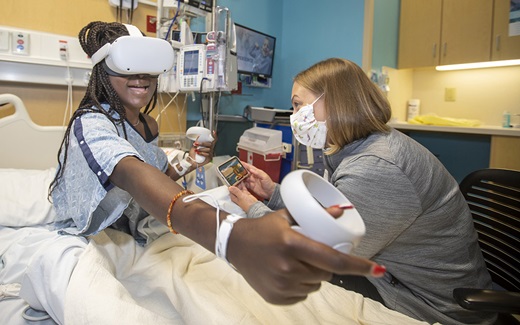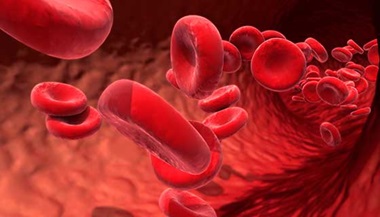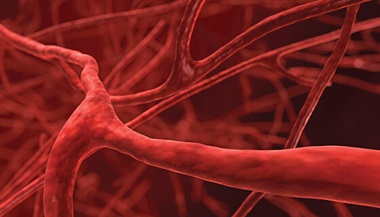Patient Story
Sickle Cell Disease and Pain Management: Abihannah's Story
Patient Story Highlights Sickle Cell Disease and Pain Management
- Abihannah is no stranger to pain. She was diagnosed with sickle cell disease at birth.
- After years of treatments, medications and therapies, Abihannah is seeing great progress and was interested in learning about a new pain management technique, virtual relief.
- For children like Abihannah who respond well, the range of options for navigating away from pain, anxiety, or discomfort are plentiful.

Pain is hard.
Abihannah knows all about that.
At age 13, she’s already navigated through more pain than many people will experience in a lifetime.
Abihannah was diagnosed at birth with sickle cell disease, an inherited blood disorder that inhibits the red blood cells’ ability to properly carry oxygen to the body.
While every patient is different, pain can be an unfortunate calling card of the disease. Severe episodes, called “pain crises,” can last from several hours to several days.
“It’s because of my blood,” Abihannah says. “My blood cells are not full, soft circles like other people’s. Mine are crescent moon shaped. They can get clogged.”
Abihannah’s mother has been by her child’s side through years of struggle, with frequent admissions to Johns Hopkins All Children’s Hospital in St. Petersburg, Florida.
“She has really suffered from it,” says her mom, Abigaelle. “The pain can sometimes be as intense as labor pains, just bone-crushing.”
Over the years, with comprehensive care from medical experts with the hospital’s Sickle Cell Disease Program, Abihannah has made progress. Pain medications and a range of therapies have been helpful to her, but the challenge to control her pain has remained a difficult one.
“It’s a very hard condition,” says Raymundo Jacinto, P.A.-C, with the Pediatric Pain Management Program at Johns Hopkins All Children’s Hospital.
“Abihannah can have pain in her arms or legs, her back, or throughout her body. Also, pain can become linked with fear, so it can be a struggle for her to start moving again.”
But during a recent hospital stay, Jacinto decided to try something different with his patient.
He introduced Abihannah — not to another IV drip or procedure or exercise — but to something a world away.
Virtual Relief
Abihannah eyed the odd-looking headset Jacinto presented with curiosity. She had heard of virtual reality (VR), but this would be her first time to try it.
There were many “experiences” to choose from. She decided on a virtual pottery experience. After some basic instruction and help donning the headset, she was on her way.
“It was very interesting!” says Abihannah.
Almost instantly, she was guided into a virtual artistic world — one that took her away from the reality of her hospital bed, away from her persistent pain.
Abihannah began “making” her pot. She could see that she had to pick up the clay and put it on her pottery table. She was moving more, engaging more than she had been.
“Especially for kids, the virtual reality space is a magical place,” Jacinto says. “They become so immersed in the audio, visual and sometimes tactile stimulation that it can be easier for the body to be distracted away from the pain.”
But there may be more than distraction at work. Research is ongoing to determine how the VR experience may impact the way the body modulates pain by functioning as a sort of non-pharmacologic analgesic.
In recent years, VR devices have been introduced in a growing number of hospitals, not just as a tool to mitigate pain, but also to help patients cope with uncomfortable procedures or anxiety.
Jacinto is encouraged by the success he is having in helping to treat certain patients’ pain with virtual reality, and he’s been working actively with a donor organization and through the hospital’s Child Life program to make more devices available for patients’ use.
Child Life specialists currently use VR devices frequently in the Cancer and Blood Disorders unit, as well as in the Emergency Center and the hospital’s MRI suite.
There are limitations with the devices. For starters, they are expensive, and the technology is changing rapidly. They also come with strict guidelines and protocols for hospital use. For example, with the devices at All Children’s, there is a list of approved experiences, and patients are restricted from using the devices online or for social networking.
Logistics also come into play. Patients need to be big enough for the headsets to fit, usually around the age of 8, in order to use them effectively.
The VR experience is not for everyone. Some patients don’t enjoy the experience or benefit from it.
But for those children who respond well, the range of options for navigating away from pain, anxiety, or discomfort are plentiful. Some virtual experiences require as little movement as a slight tilt of the head, whereas others may engage in full body activity.
“There’s an experience, for example, where you are coloring in a coloring book and it comes alive around you,” Jacinto says. “There are very simple games, like one where you can walk a puppy through outer space, or a more active one where you can meet Darth Vader and get trained in ‘the force.’”
“You can interact with endless things to take your mind off your pain,” Abihannah says. “It never gets old.”
As the body of research regarding the best use of virtual reality devices in clinical settings grows, clinicians are working to tailor the experiences more to individual patients’ needs.
For her birthday this year, Abihannah’s mom gave her her very own virtual reality headset. While it doesn’t take away all of her pain, it offers a tool that helps make life a little easier during the toughest times.
“We can’t take her sickle cell away,” Jacinto says. “I wish we could. But it brings me great joy that we could help Abihannah to discover something that makes a difference for her.”
Abihannah's Treatment Team
Pain Management at Johns Hopkins All Children's Hospital
The pain management program at Johns Hopkins All Children's Hospital in St. Petersburg, Florida, uses medications or procedures along with therapies such as psychotherapy, biofeedback, occupational and physical therapy solely dedicated to the management of pain.





